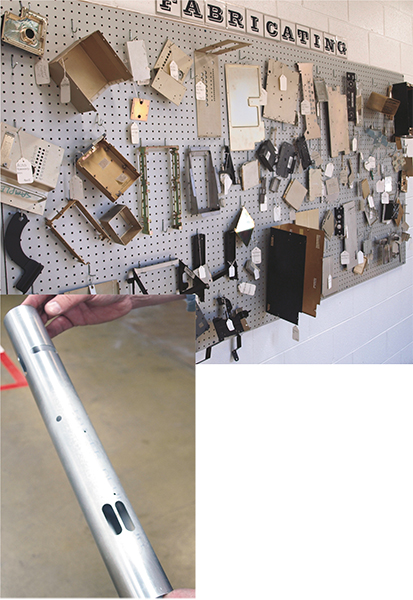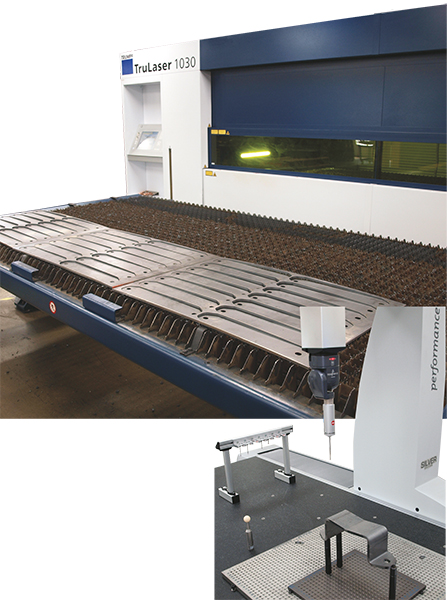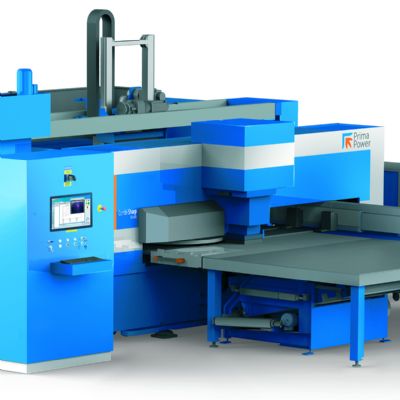Surprise—Thin on the CO2, Thicker on the Fiber
Touring the designated laser-cutting area of the shop, home to the Trumpf cutting-machine duo, we spied a somewhat surprising dynamic—the CO2-laser cutting machine was going to town on 0.060-in.-thick cold-rolled steel, while the fiber-laser machine sliced through thicker 0.312-in. steel plate.
“We often run very thin material (as thin as 0.010-0.015 in.) on the CO2 machine,” shares Wagy, “because we find that the higher gas pressure associated with the fiber machine can blow the small parts out of the blank. We get better process control on these more delicate parts on the CO2 machine.
“Otherwise,” Wagy continues, “for parts 1 to 3 mm thick the fiber machine definitely outperforms the CO2 machine when it comes to speed and productivity. We find that the advantages of the CO2 machine—other than on very delicate parts—come into play for material thicker than 5 mm.”
To supply gas to its laser-cutting machine, Tella recently invested in bulk liquid-nitrogen and oxygen tanks. The tanks reside near the backdoor to the plant, enabling quick service from the firm’s gas distributor.

Tella Tool’s display of fabricating work features an array of laser-cut, turret-press punched and press-brake formed parts for customers in the electronics, aerospace, telecommunications and other industries. Cutting the tubular part (left)—which goes into an aircraft fueling system—on its fiber-laser machine required the firm to develop a special cradle fixture.
“We have a telemetry system in place,” says Wagy, “that alerts our distributor when levels get low. This ensures that we’ll never run out of cutting gases. And we’ve eliminated the hassles of cylinder deliveries and handling.”
Perfecting High-Mix Low-Volume Fab
Early in its laser-cutting adventure, Tella Tool found success earning work with very short runs (40 to 50 parts) nested onto small blanks sheared to size inhouse, or supplied by its service center. And, much of that work also required preprocessing on the firm’s turret presses, to punch holes or perform forming operations. Now, much of the growth in Tella Tool’s laser-cutting operations is from new customers with larger order volumes—1000- to 1500-piece runs that allow the company to run 4- by 10-ft. sheets. Along with this increase in order size has come the move to a kanban system for managing production through the fabrication department—turret presses, lasers and press brakes.
“We can turn jobs in three days typically, and more quickly if required,” says Wagy. “The move to kanban has been very successful in helping us control inventory and improve production efficiency.”
“Evolving into the high-mix low-volume world,” shares Prince, “required a significant investment in hiring the right people and building their skill sets. And we’ve had to improve our scheduling and develop expertise in logistics. On the fab side of the building, we often have to schedule a series of processes that follow turret-press punching and laser cutting, including bending, hardware insertion, e-coating and assembly. Logistics on the stamping side are typically much simpler. And we have had to learn to communicate much more thoroughly and effectively with our suppliers and our customers.
“Last but certainly not least,” Prince continues, “we’re close to investing in a new ERP system, to help us manage the rapidly increasing complexity of our business.”
Of course, as part volumes rise in fabrication—to 2000 or more typically—the temptation to add hard tooling to the job, in part or in total, becomes greater.
“For example,” explains Wagy, “we can tool the complete part run in a progressive die and run from coil, or we can laser-cut blanks and move those to a secondary die and add the required bends to the parts.“We have one laser-cut part, for example,” Wagy continues, “that requires six bends in a press brake. We’re looking at whether or not we can complete that part in a two-out secondary stamping die as volumes increase.”
A Short Learning Curve that Doesn’t End
Prince and Wagy agree that while integrating new laser technology into the company’s production processes occurred relatively quickly and painlessly, perfecting their use requires climbing an ongoing learning curve. In the shop, Wagy says that programming the cutting machines has not created any notable challenges—the firm uses FabriWin CAD-CAM software, from Metalsoft, to enter approximately four new part numbers into the laser-cutting machines per week.
However, supervisor Yanel Lopez explains that learning how to fine-tune process parameters on the shop floor is where significant efficiency gains can be found. When we visited, Lopez had recently attended fiber-laser training at Trumpf, in Farmington, CT, and had picked up some CO2 operating tips at the same time.
“We’re always fine-tuning our laser-process parameters to increase speed and improve quality,” Lopez explains. “Often this means modifying the ‘tech tables’ of parameters, including gas pressure and laser power. For example, the parameters programmed into the controller relate to specific types of material and the thickness of the sheet or plate. When we have to cut a material type of workpiece thickness that doesn’t exactly match what’s programmed into the controller, we have to ‘dial-in’ or fine-tune the parameters.”
Asked to cite a recent example, Lopez points to the job running on the CO2 laser during my visit—the 0.060-in. cold-rolled steel sheet.
“At first, we were burning the part edges,” Lopez says. “I increased the gas pressure from 1.5 to 3 bars, and now we’re not only getting cleaner cuts but we’re cutting faster.”
On the fiber front, one operating tip quickly became evident.
“We have to be diligent about maintaining the machine and keeping the lens clean,” says Lopez. “For example, cutting the 0.312-in.-thick material can cause spatter from piercing to splash up and stick to the lens. This will diminish beam quality and cause burrs on the bottom of the cut parts. Sticking to a prescribed preventive-maintenance schedule will avoid that problem. MF
View Glossary of Metalforming Terms
See also: TRUMPF Inc.
Technologies: Cutting










